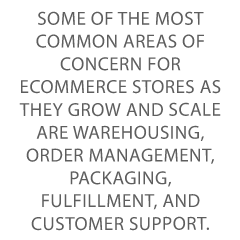In today’s fast-paced digital world, running a successful eCommerce or online business requires careful management of many financial aspects. One crucial factor that can significantly impact the health of your eCommerce business is how money moves within your business ecosystem.
Are you aware of the potential pitfalls and risks of bad money moves? From inefficient processes to lost sales opportunities, we will explore all the ways bad money moves can hurt your eCommerce business.
Additionally, we’ll share valuable insights to help you avoid mishandling money!
This blog post may contain affiliate links, meaning when you click the links for some products and make a purchase, Credit Suite receives a commission at no additional cost to you.
Prioritizing tech and admin over fulfillment and operations
Many startups are so drawn to cool features of new tools that they end up with a tech stack that’s all over the place and lacks centralization. One or two well-organized project management tools can do wonders!
By investing all their time and resources into “the perfect tech stack”, business owners tend to forget about the most important part of their business — efficient eCommerce fulfillment and inventory storage operations.
 According to recent McKinsey insights, fulfillment speed and efficiency are of utmost importance for customer experience and loyalty, especially when it comes to omnichannel sales. Divert your attention toward perfecting the backend of your business in a way that no spikes or surges in demand can throw you off track.
According to recent McKinsey insights, fulfillment speed and efficiency are of utmost importance for customer experience and loyalty, especially when it comes to omnichannel sales. Divert your attention toward perfecting the backend of your business in a way that no spikes or surges in demand can throw you off track.
Remember that the role of tech tools is to simplify processes and make them more efficient, not to slow you down and distract you from the actual job at hand.
Underinvesting or misinvesting
Underinvesting is literally a bad money move. In the case of eCommerce stores, for instance, we see businesses that underinvest in cybersecurity. Since eCommerce relies on online transactions, you can see how an insecure store or payment method can be risky.
Likewise, misinvesting is the second literal bad money move you could make. According to a recent CB Insights report, running out of cash or capital is the number one reason for startup failure. Misinvesting is what mainly puts fresh entrepreneurs in this majority.
Sometimes, misinvesting can mean betting everything on one card. In the case of eCommerce, that could be spending a year developing a product without actually testing the market in advance, only to figure out that there’s no demand for such a product to start with.
Other times, misinvesting can be smaller, but still impactful — for instance, investing in the wrong marketing channel.
Missing sales opportunities (AKA leaving money on the table)
When it comes to eCommerce stores, multichannel or omnichannel sales are typically the norm — and that’s how it should be if you want a great customer experience.
However, selling on multiple channels also means needing more control over the buyer’s journey and sales process. Otherwise, you’ll surely be leaving money on the table.
A good example is failing to recover abandoned carts. A simple follow-up email reminding the shopper that they forgot about their cart could be enough to nudge them in the right direction and close the sale.
The next mistake we commonly see in eCommerce stores is failing to upsell and cross-sell at checkout.
If you have a large product offering, especially if you sell products that complement each other, simply placing a section with “Products you might also like” or “Products that go well with this” can do wonders!
Another common mistake is not leveraging email leads. To maximize sales, try some of these strategies:
- use AI to personalize emails
- send out welcome emails with incentives such as codes for discounts
- announce new products or collections at launch
- give vouchers or coupons to loyal customers
- launch seasonal sale campaigns.
Creating difficulties with operations at scale
If everything goes well, your business will reach a point where you need to scale operations — everything from supply to fulfillment needs to increase and become more efficient. Unsurprisingly, this is typically the point where entrepreneurs start struggling.
 Some of the most common areas of concern for eCommerce stores as they grow and scale are warehousing, order management, packaging, fulfillment, and customer support.
Some of the most common areas of concern for eCommerce stores as they grow and scale are warehousing, order management, packaging, fulfillment, and customer support.
Depending on the nature of your business, a possible solution would be to outsource your storage, packaging, and delivery needs to a specialized fulfillment company.
If you’re struggling to maintain satisfactory stock levels and meet customer demands, diversifying your supply chain partner network could be a great solution. This will give you more security and flexibility, and reduce the risks you run working with only one supplier.
At this stage, you might even want to learn how business loans work and use one to help push your business scale. After all, from nothing comes nothing — so scaling without investing parts of your gains is unrealistic.
Failing to meet customer expectations
Connected to the previous two points, if you attempt to scale a business before you’re ready (in terms of operations and processes), another area that might suffer is your customer service and overall customer experience.
Many eCommerce stores, especially at the beginning, start out as a one-person show. Later on, it might turn into a small team, but often not enough to handle everything smoothly like before.
When eCommerce businesses miss staff and resources, customers are always the ones to suffer.
In your store, you might recognize a decline in customer service by the following signs:
- backorders piling up
- missing or delayed deliveries
- longer order fulfillment
- increased customer complaints
- lower ratings or reviews
- a surge in sales numbers
- increased return or refund requests.
Failing to track marketing spend
There are many ways to minimize business expenses, but a large portion of it is typically reserved for marketing. That’s why it’s so important to monitor and track your marketing efforts and be aware of where your budget goes.
When you look at the big picture, this can mean limiting your budget for traditional marketing and doubling down on online marketing.
If we go more into detail, this can also refer to A/B testing two different ads and then taking action — kill the one that doesn’t work and scale the one that does.
Wrapping up
Notably, unwise money moves can have a detrimental impact on eCommerce businesses. From overspending on unnecessary expenses to failing to maintain customer satisfaction while scaling, these mistakes can lead to financial instability and even bankruptcy.
By understanding the importance of financial planning and making sound decisions, businesses can thrive and achieve long-term success. In the case of multichannel eCommerce businesses, learning how to distribute your budgets properly is that much more important.
Hopefully, our guide will help you avoid these common bad money moves and save your business financial distress in these ever-evolving and competitive market conditions.


